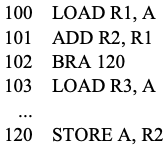Assume a classical RISC pipeline with regular (not delayed) branches. This pipeline has five stages: Instruction Fetch (IF), Instruction Decode (ID), Execute Instruction (EX), Memory Access (MEM), and Writeback (WB). You may assume that there are no resource hazards in this pipeline, but data hazards may exist. Draw a timing diagram that shows the execution of the following instructions in this pipeline. Assume that R1, R2, etc. are registers while A, B, etc. are memory operands. The first operand is the destination while the second operand is the source. The numbers on the left are the addresses of the instructions. BRA is an unconditional branch to a target address 120.
Assume a classical RISC pipeline with regular (not delayed) branches. This pipeline has five stages: Instruction Fetch (IF), Instruction Decode (ID), Execute Instruction (EX), Memory Access (MEM), and Writeback (WB). You may assume that there are no resource hazards in this pipeline, but data hazards may exist. Draw a timing diagram that shows the execution of the following instructions in this pipeline. Assume that R1, R2, etc. are registers while A, B, etc. are memory operands. The first operand is the destination while the second operand is the source. The numbers on the left are the addresses of the instructions. BRA is an unconditional branch to a target address 120.
Computer Networking: A Top-Down Approach (7th Edition)
7th Edition
ISBN:9780133594140
Author:James Kurose, Keith Ross
Publisher:James Kurose, Keith Ross
Chapter1: Computer Networks And The Internet
Section: Chapter Questions
Problem R1RQ: What is the difference between a host and an end system? List several different types of end...
Question

Transcribed Image Text:100
LOAD R1, A
101
ADD R2, R1
BRA 120
102
103
LOAD R3, A
120 STORE A, R2

Transcribed Image Text:Assume a classical RISC pipeline with regular (not delayed) branches. This pipeline has five stages:
Instruction Fetch (IF), Instruction Decode (ID), Execute Instruction (EX), Memory Access (MEM),
and Writeback (WB). You may assume that there are no resource hazards in this pipeline, but data
hazards may exist.
Draw a timing diagram that shows the execution of the following instructions in this pipeline. Assume
that R1, R2, etc. are registers while A, B, etc. are memory operands. The first operand is the destination
while the second operand is the source. The numbers on the left are the addresses of the instructions.
BRA is an unconditional branch to a target address 120.
Expert Solution
This question has been solved!
Explore an expertly crafted, step-by-step solution for a thorough understanding of key concepts.
This is a popular solution!
Trending now
This is a popular solution!
Step by step
Solved in 2 steps with 1 images

Recommended textbooks for you

Computer Networking: A Top-Down Approach (7th Edi…
Computer Engineering
ISBN:
9780133594140
Author:
James Kurose, Keith Ross
Publisher:
PEARSON

Computer Organization and Design MIPS Edition, Fi…
Computer Engineering
ISBN:
9780124077263
Author:
David A. Patterson, John L. Hennessy
Publisher:
Elsevier Science

Network+ Guide to Networks (MindTap Course List)
Computer Engineering
ISBN:
9781337569330
Author:
Jill West, Tamara Dean, Jean Andrews
Publisher:
Cengage Learning

Computer Networking: A Top-Down Approach (7th Edi…
Computer Engineering
ISBN:
9780133594140
Author:
James Kurose, Keith Ross
Publisher:
PEARSON

Computer Organization and Design MIPS Edition, Fi…
Computer Engineering
ISBN:
9780124077263
Author:
David A. Patterson, John L. Hennessy
Publisher:
Elsevier Science

Network+ Guide to Networks (MindTap Course List)
Computer Engineering
ISBN:
9781337569330
Author:
Jill West, Tamara Dean, Jean Andrews
Publisher:
Cengage Learning

Concepts of Database Management
Computer Engineering
ISBN:
9781337093422
Author:
Joy L. Starks, Philip J. Pratt, Mary Z. Last
Publisher:
Cengage Learning

Prelude to Programming
Computer Engineering
ISBN:
9780133750423
Author:
VENIT, Stewart
Publisher:
Pearson Education

Sc Business Data Communications and Networking, T…
Computer Engineering
ISBN:
9781119368830
Author:
FITZGERALD
Publisher:
WILEY